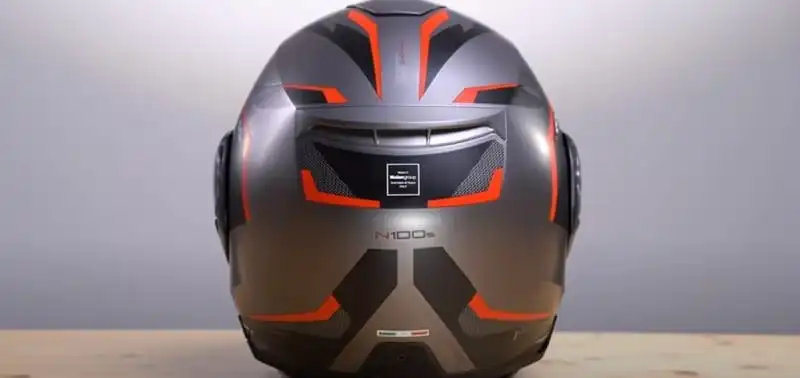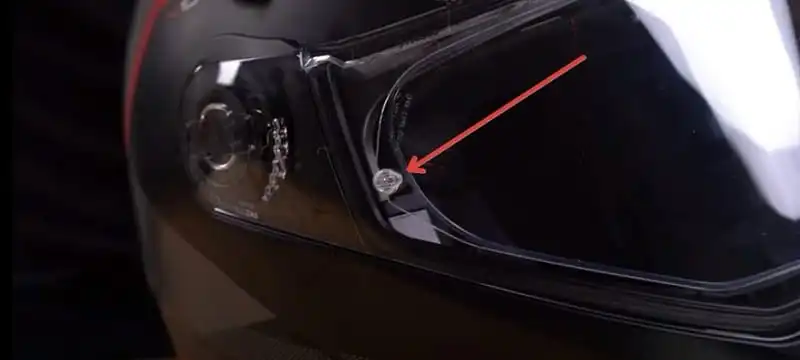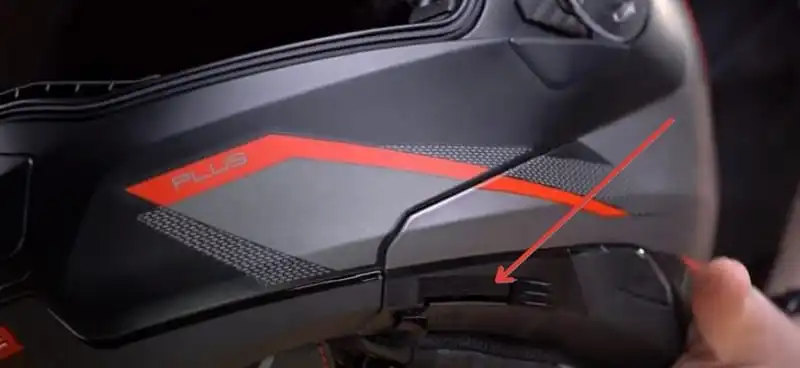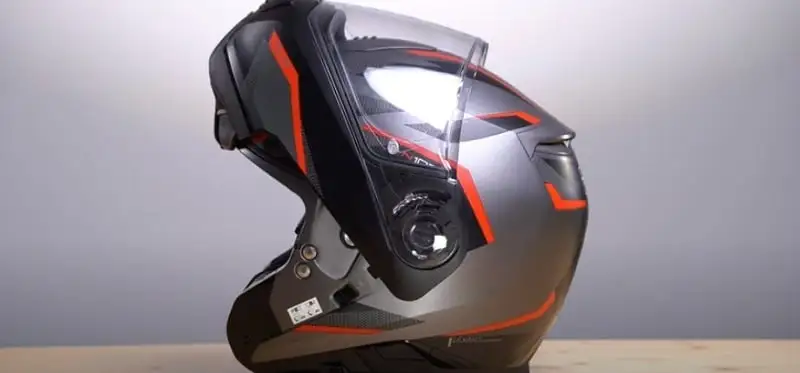The N100-5 Plus is Nolan’s top-of-the-range modular helmet, although I’m looking at two lids in one review: the N105 and the N105 Plus.
There’s very little difference between the two helmets. The Plus model has a better lining that I’ll explain in a few minutes. Otherwise, the two helmets have exactly the same construction.
I’ve had a lot of respect for Nolan helmets for a while now, and this helmet has only enhanced my regard for what they do in the time I’ve spent with it.

Nolan N100-5 Plus Flip-up Review
Shell Construction
It’s made with a plastic shell, and Nolan has used a high-quality polycarbonate called Lexan since Nolan was first founded 50 years ago.
The overall build quality on this helmet is typically good. However, the plastic shell does mean this helmet isn’t exactly lightweight.
The size medium N105 Plus comes in at 1754 grams/3.8 lbs on our scales.
Before I get too carried away about the plastic shell being the cause of the weight, let’s put some perspective on that.
The X-1005 flip front that Nolan’s sister company makes, X-lite, has a composite fiber shell that weighs almost the same as this helmet.
It was one gram heavier than this Nolan, and in the time I spent wearing this helmet, it didn’t once feel like I was wearing a heavy lid.
But sometimes a heavier lid is fine if it’s well balanced, and that’s how I felt when I was wearing this one.

Chin Bar
The chin bar on this follows Nolan’s usual system with a two-stage release.
First, pushing the lower of the two red switches away from the chin bar releases the upper switch, then you pinch the two together, which frees the chin bar mechanism.
Some people say that’s fiddly compared to helmets with the chin bar released on one button.
I can’t argue with that statement as it is a bit fiddly. But, Nolan has a brilliant record for their chin bars staying closed in the impact tests carried out as part of the UK government’s Sharp tests.
Nolan has a 100 success rate as not one of their lids has ever opened up in a sharp impact test. It’s the same story for their sister company’s helmets.
They use the same two-stage setup for their operation in how the chin bar opens and keeps the helmet compact.
It doesn’t just flip up as it rises. Instead, it flips back simultaneously, thanks to an elliptical trajectory.
So when the chin bar is lifted, the tip at the chin sits barely proud of the front of the helmet, giving it a better shape when you’re using it with the chin bar raised.
It’s legal to do that, thanks to the dual homologation of the helmet. It’s tested as an open face with the chin bar up and a full face with it down.
A slider on the side of the helmet locks the chin bar up, which means it’s a fully tested open-face lid.
Then, lowering the chin bar locks shut with a satisfying clunk.
Ventilation
The venting on the helmet is pretty impressive and comprehensive. For example, the slider on the chin bar reveals a vent that draws air up to the inner surface of the visor and around the eye port.
There is another slider on top that pulls air inside the helmet. It doesn’t seem to be a direct route from the shell to your head, but it seems as though air can travel between two sections of the EPS impact liner.
This will cool that material down as it travels through channels toward exhaust vents at the rear.
Those exhaust vents at the back are permanently open, becoming the go-to method for helmets.
Visor
The visor for this helmet gives plenty of peripheral vision and is protected against mist by a Pinlock insert fitted as standard.
This will save you another fiddly job if you ever need to mess around with the insert or clean it, and the visor’s easy to remove.
There are simple adjusters on the outside to tune the pin lock tension without being too fiddly.

The visor has five stages on its journey from top to bottom, and then it takes just a little extra push to secure it on its central tab.
The penultimate stage of the movement leaves it slightly open so that you can get a little more air on the inside.

Sun Visor
The main visor is backed up by a sun visor that closes in stages. There are four steps, and then it has Nolan’s speedy retraction set up where pushing this button retracts the visor in one simple motion.

The sun visor follows the norm for Nolan; it’s anti-fog treated. I suffer quite a lot with visor misting, so having that anti-fog coat is an important feature for someone like me.
Interior
This is another area where Nolan often stands out from the crowd. Whether you go for the Plus model or the straight N105, you get a pleasant soft foam lining that’s comfortable next to your skin.
It fits securely into the helmet and is fully removable for washing. If you go for the N105 Plus, you can adjust the lining, so the helmet sits on your head at a different angle.
It’s got what’s called Nolan’s liner positioning control. If you adjust the tabs on the inside, so they’re closer together, the helmet tilts a little bit forward on your head.
If you keep them further apart, the helmet will sit more neutrally on top of your head.
The Plus model also has a net section at the top of the liner to allow some extra airflow around the top of your head.
The cheaper of the two helmets, the N105 has a mesh bit mesh part just above the eye section. The N105 Plus has a synthetic leather mesh section at the net’s top.
There’s also a modification on the cheek pads. The Plus model has a different section around the base of the cheek pad instead of just a straight cheek pad that you get on the N105.
It provides extra protection against the wind because you’ve got a slightly closer fit around the neck on the Plus model.
Other than the two liners there’s no difference between the helmets.
Bluetooth
There are recesses to allow speakers to fit comfortably in this helmet. It is set up for Nolan’s N-Com systems, or you can fit a Center universal system because Cena makes the N-Com units for Nolan.
If you’ve already got a Cardo system, you may be out of luck. The recesses in this are too small for the speakers on the Cardo PACKTALK Bold that I tried to fit into this lid.

Safety Straps
Finally, with the interior, the strap fastener is a micrometric quick-release buckle.
Again, it’s as you’d expect with a flip front helmet, but as with the chin bar mechanism, there’s an extra layer of security on this fastener.
The red part of the release tab has to pivot before the gray part. The section can then be pulled open to release its grip on the toothed slider.
Again, Nolan says this reduces the chances of that fastener accidentally opening, and it’s hard to disagree with that logic.
Sizing

The N105 and N105 Plus meet ECE 2205 for use on the road in dual homologation form.
Unfortunately, as I said earlier, there’s no ACU gold stamp, so if you’re that rare beast who wants a flip-front helmet for competition use, you’ve just read this for no reason.
However, this helmet has been tested by Sharp. It scored four stars out of five, which is a solid score.
The N105 and the Plus are available in sizes ranging from double extra small to triple extra large. In addition, there are two shell sizes to cover the range of helmet sizes.
Helmet sizes medium and below share, and the smaller shell and lid sizes from large and above go into that bigger shell.
But, there are six different thicknesses of EPS impact liner, so the smaller helmet size isn’t just chock full of thicker comfort padding to fill that space.
The two smallest lids share an EPS thickness, as do the two biggest lids in that range.
So that means everything from small to extra large has its own EPS liner size, which helps ensure a decent fit and the proper protection level.
You might have picked up that I like this helmet, and you’d be right. When I wore it, it felt comfortable for my head shape. It felt safe and wasn’t noisy, although I was wearing earplugs.
It’s not a cheap flip front this helmet, although you might find a discount on an old paint scheme if you’re looking at the right time of year.
But the real headline flip front helmets like Shoei and Schuberth are much more expensive. So I think a helmet like this is well worth looking at before you decide whether to pay the extra for the Plus model over the straight N105.

In Conclusion
This motorcycle helmet is one of the most advanced helmets that we have ever seen. With its unique combination of technologies, Nolan makes this helmet one of the best helmets you can buy for the price.
The polycarbonate shell is one of the strongest available in the market today, and its two sizes (2XS-MD, LG-3XL) make it very versatile.
It can be used with the chin guard open or closed, and it comes with a Pinlock fog-resistant face shield that protects your eyes from the sun and other harmful rays.
The ventilation system is one of the most advanced we have ever seen, and it helps keep you cool and comfortable during long rides.
It has an air booster technology that keeps you cool and comfortable even when exposed to the sun.
This helmet also has an elliptical trajectory for the chin guard, making reaching the open position easier.
The chin guard is also rotationally adjustable to help you easily get the best fit.
The Microlock double lever chin strap retention system is one of the best systems on the market, and it helps you stay secure and in place.
It also has a speaker pocket that you can use to listen to music while riding.
This helmet is ready for the Nolan N-Com communication system. This helmet is one of the most versatile and protective motorcycle helmets we have ever seen.



